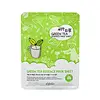What's inside
What's inside
 Key Ingredients
Key Ingredients

 Benefits
Benefits

 Concerns
Concerns

 Ingredients Side-by-side
Ingredients Side-by-side

Water
Skin ConditioningGlycerin
HumectantPropanediol
SolventGlycereth-26
HumectantNiacinamide
Smoothing1,2-Hexanediol
Skin ConditioningSea Water
HumectantGlyceryl Glucoside
HumectantArginine
MaskingBetaine
HumectantXanthan Gum
EmulsifyingCarbomer
Emulsion StabilisingTrehalose
HumectantPanthenol
Skin ConditioningAllantoin
Skin ConditioningXylitylglucoside
HumectantPolyglyceryl-10 Laurate
Skin ConditioningAnhydroxylitol
HumectantZeolite
AbsorbentPolyglyceryl-4 Laurate
EmulsifyingGlucose
HumectantOctyldodeceth-16
EmulsifyingXylitol
HumectantTocopherol
AntioxidantHydroxyethylcellulose
Emulsion StabilisingLavandula Angustifolia Oil
MaskingGlycine
BufferingGlutamic Acid
HumectantAspartic Acid
MaskingSodium Polyacrylate
AbsorbentSodium Chloride
MaskingDisodium EDTA
Ceramide NP
Skin ConditioningAnastatica Hierochuntica Extract
AstringentSerine
MaskingHistidine
HumectantAlanine
MaskingThreonine
Proline
Skin ConditioningAcrylates/C10-30 Alkyl Acrylate Crosspolymer
Emulsion StabilisingMagnesium Chloride
Calcium Chloride
AstringentParfum
MaskingWater, Glycerin, Propanediol, Glycereth-26, Niacinamide, 1,2-Hexanediol, Sea Water, Glyceryl Glucoside, Arginine, Betaine, Xanthan Gum, Carbomer, Trehalose, Panthenol, Allantoin, Xylitylglucoside, Polyglyceryl-10 Laurate, Anhydroxylitol, Zeolite, Polyglyceryl-4 Laurate, Glucose, Octyldodeceth-16, Xylitol, Tocopherol, Hydroxyethylcellulose, Lavandula Angustifolia Oil, Glycine, Glutamic Acid, Aspartic Acid, Sodium Polyacrylate, Sodium Chloride, Disodium EDTA, Ceramide NP, Anastatica Hierochuntica Extract, Serine, Histidine, Alanine, Threonine, Proline, Acrylates/C10-30 Alkyl Acrylate Crosspolymer, Magnesium Chloride, Calcium Chloride, Parfum
 Reviews
Reviews

Ingredients Explained
These ingredients are found in both products.
Ingredients higher up in an ingredient list are typically present in a larger amount.
Betaine is a common humectant (a substance that promotes retention of moisture). It's known to be gentle on the skin and can help balance hydration.
This ingredient is best for improving hydration and soothing irritated skin. Studies also show it helps even out skin tone.
Fun fact: Betaine is naturally created in the skin and body. The kind found within cosmetic products can be either plant-derived or synthetic.
Another name for betaine is trimethylglycine.
Learn more about BetaineCarbomer is a polymer of acrylic acid. Its main role is to create a gel consistency.
A high amount of carbomer can cause pilling or balling up of products. Don't worry, most products contain 1% or less of carbomer.
Glycerin is already naturally found in your skin. It helps moisturize and protect your skin.
A study from 2016 found glycerin to be more effective as a humectant than AHAs and hyaluronic acid.
As a humectant, it helps the skin stay hydrated by pulling moisture to your skin. The low molecular weight of glycerin allows it to pull moisture into the deeper layers of your skin.
Hydrated skin improves your skin barrier; Your skin barrier helps protect against irritants and bacteria.
Glycerin has also been found to have antimicrobial and antiviral properties. Due to these properties, glycerin is often used in wound and burn treatments.
In cosmetics, glycerin is usually derived from plants such as soybean or palm. However, it can also be sourced from animals, such as tallow or animal fat.
This ingredient is organic, colorless, odorless, and non-toxic.
Glycerin is the name for this ingredient in American English. British English uses Glycerol/Glycerine.
Learn more about GlycerinParfum is a catch-all term for an ingredient or more that is used to give a scent to products.
Also called "fragrance", this ingredient can be a blend of hundreds of chemicals or plant oils. This means every product with "fragrance" or "parfum" in the ingredients list is a different mixture.
For instance, Habanolide is a proprietary trade name for a specific aroma chemical. When used as a fragrance ingredient in cosmetics, most aroma chemicals fall under the broad labeling category of “FRAGRANCE” or “PARFUM” according to EU and US regulations.
The term 'parfum' or 'fragrance' is not regulated in many countries. In many cases, it is up to the brand to define this term.
For instance, many brands choose to label themselves as "fragrance-free" because they are not using synthetic fragrances. However, their products may still contain ingredients such as essential oils that are considered a fragrance by INCI standards.
One example is Calendula flower extract. Calendula is an essential oil that still imparts a scent or 'fragrance'.
Depending on the blend, the ingredients in the mixture can cause allergies and sensitivities on the skin. Some ingredients that are known EU allergens include linalool and citronellol.
Parfum can also be used to mask or cover an unpleasant scent.
The bottom line is: not all fragrances/parfum/ingredients are created equally. If you are worried about fragrances, we recommend taking a closer look at an ingredient. And of course, we always recommend speaking with a professional.
Learn more about ParfumWater. It's the most common cosmetic ingredient of all. You'll usually see it at the top of ingredient lists, meaning that it makes up the largest part of the product.
So why is it so popular? Water most often acts as a solvent - this means that it helps dissolve other ingredients into the formulation.
You'll also recognize water as that liquid we all need to stay alive. If you see this, drink a glass of water. Stay hydrated!
Learn more about Water